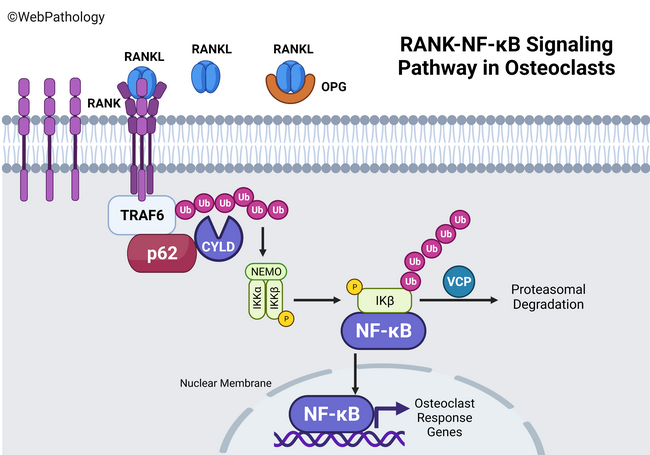Paget Disease of Bone : RANK-NF-κB signaling


Comments:
NF-κB is a transcription factor and a key component of RANKL-mediated NF-κB signaling pathway that is involved in the recruitment and differentiation of osteoclast precursors. It is reviewed here in order to understand the mechanism of action of SQSTM1 mutations (next image) in the pathogenesis of Paget disease of bone. Osteoclast precursors express surface receptors called RANK (receptor activator of nuclear factor-kappa B). RANK is a member of the tumor necrosis factor receptor superfamily. RANK is activated by RANK ligand (RANKL) which is secreted by osteoblasts. Activation of RANK by RANKL promotes the maturation of osteoclast precursors into osteoclasts. Following activation, RANK undergoes trimerization and its cytoplasmic tail forms a complex with adaptor protein TRAF6, p62 (SQSTM1) and CYLD. TRAF6 uses its ubiquitin-ligase activity and undergoes ubiquitination. Subsequently, after a series of steps, a complex consisting of IKKβ, IKKα, and NEMO is activated. This phosphorylates Iκβ which is ubiquitinated. The polyubiquitin chain targets Iκβ, under control of VCP (valosin containing protein), for proteasomal degradation releasing NF-κB. This results in movement of NF-κB into the nucleus and activation of osteoclast-specific response genes. The negative regulator of this pathway in osteoclasts is a deubiquitinating enzyme CYLD which binds to the UBA domain of p62, forming the RANK-TRAF6-p62-CYLD complex. CYLD deubiquitinates and inactivates TRAF6 which shuts down the pathway. Deletions or missense mutations in SQSTM1 gene that alter UBA domain impair the binding between CYLD and p62 and result in osteoclast overactivity (as discussed in the next image). Osteoprotegerin (OPG) is an endogenous, soluble protein, secreted by osteoblasts, that binds to RANKL and prevents its interaction with RANK, thereby shutting down the NF-κB signaling pathway. Reference: Ralston SH & Layfield R. Pathogenesis of Paget Disease of Bone. Calcif Tissue Int (2012) 91:97-113. Credit: Illustration created with BioRender.com



